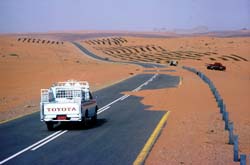
WORKING PARTY
The Working Party first met in late 2003, under the Chairmanship of John Charman, who led a multidisciplinary team of desert specialists drawn variously from engineering and geoscience backgrounds and representing commercial, consultancy and academic activities (see online version). An invaluable aspect of the report’s compilation was a thorough process of regular peer review as the chapters took shape. The Working Party had regular face-to-face meetings for five years, where issues were thrashed out and chapter drafts openly discussed and improved. Therefore the whole Working Party is jointly responsible for every chapter in this handbook.
Along the way, the Working Party received help from many acknowledged correspondents and benefited from a dedicated session at the International Association for Engineering Geology Congress in Nottingham in 2006. Once the report/book had been compiled and edited, Professor Sir Ronald Cooke, a renowned geomorphological pioneer in desert regions honoured the Working Party with a Foreword, concluding: "This comprehensive, state-of-the-science review successfully brings together the experience gained over recent years of many engineering geomorphologists and geologists into one volume. It integrates knowledge of the landforms and the processes that have worked on them over time with studies of the nature and behaviour of materials, appropriate techniques of analysis, and guidelines for the choice of engineering designs, construction methods and materials. It should be an essential guide to all who seek to develop land in hot deserts."
When we reached the end of our main ‘face-to-face’ compilation period in 2008, prior to the lengthy process of detailed editing, the Working Party unanimously agreed to dedicate the volume to Peter Fookes. As well as being timely recognition of his tireless support for the Engineering Group and many of its members individually, this was also appropriate because of his unrivalled contribution to the partnership between geologists and engineers in understanding, confronting and ultimately solving the many challenges facing successful construction in hot desert regions.
The handbook can be used as a reference work, aided by a detailed index, an extensive specialised glossary distilled from the various chapters, and extensive reference lists supporting each chapter. However, it can equally be used as a textbook, for work, education or – we hope - just for pleasure! To these ends, following a scene-setting introductory first chapter, the report is structured into three main themes: Geological and geomorphological background (Chapters 2 to 4), Investigation and testing (5 to 7) and Engineering behaviour (8 to 10): (See online for more detail). All chapters are copiously illustrated, including many images and diagrams in colour, courtesy of generous sponsorship from Arup, Fugro and Fugro-Suhaimi.
Professor David Nash leads off in Chapter 2 with a geographical overview, including the distribution of hot deserts, causes of aridity, controls over diversity, and discussion of past and future changes. This review is complemented by an extensive account of desert processes and the landforms they create in Chapter 3, from Professor Jim Griffiths and his team. Processes are presented in four categories: weathering and duricrust formation; wind, sand and dust; fluvial; and subsurface water, salts and aggressive ground.